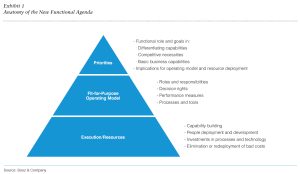Until recently, the role of corporate functions such as HR, marketing, and IT, was relatively straightforward.
These organizations carried out essential governance roles and specialized tasks that allowed the company to function on a daily basis. HR managed recruitment, benefits transactions, and the evaluation and promotion process. IT ran and supported computer systems. Finance managed accounts, debts, and taxes.
All worked to accommodate requests from various business units and to put out the inevitable fires that erupted during times of conflict or urgency.
While critical, these roles essentially existed to fulfill day-to-day needs. When functional leaders were asked to improve, that meant doing these same tasks – just more efficiently.
Functions playing a more strategic role
Over the past several years, however, CEOs, business unit leaders, and functional leaders themselves are asking new questions. How can functions play a more strategic role? How can they deliver more value to the organization? How can they earn a “seat at the table?”
Several forces are driving this shift, among them:
- Unstable market environments and increasing competitiveness.
- Companies becoming more focused around their core differentiating capabilities.
- Functions becoming more efficient than ever, thereby freeing up resources.
- Increasing pressure on flawless execution of transactional tasks.
In order to make the most of this transition, HR leaders must become “fit for purpose,” instead of striving to be “best in class” in everything they do. This means reallocating and managing resources to focus on activities that are strategically important to the enterprise and that drive their company’s distinctive value proposition – no small task.
HR = Strategy Driver
These rising demands offer HR leaders and their organizations a ripe new opportunity to play a larger role in driving strategy, and help companies define, build, and grow their differentiating capabilities: the things they do better than anyone else, and that are nearly impossible for competitors to replicate.
The most successful companies closely link their value proposition to these critical capabilities. For instance, Amazon’s strategy is based on its skill building online user interfaces and streamlining logistics processes; simplifying the shopping experience for consumers. Walmart’s success depends on its ability to keep prices low and make shopping convenient.
For companies to grow their differentiating capabilities, they need HR to help define and maintain them, since talent is a critical part of what creates differentiation. But how do HR executives embrace this new strategic responsibility? How can the function as a whole emphasize high-value, strategic activities — while still “managing its own house” of existing, demanding responsibilities?
HR leaders need a road map for how to resolve this dilemma. They need help moving the function toward a clearer set of priorities; making it more insight-driven and more aligned to the enterprise strategy. Simply put, they need a new functional agenda – a playbook for the new strategic role they (and their staff) are assuming
A new functional agenda
In order to successfully make this shift within the framework of the new functional agenda, HR leaders must address and implement the following three core elements:
- First, establishing priorities in line with the company’s overall strategy and the enabling role of the function;
- Second, aligning the operating model to deliver value in line with those critical priorities; and,
- Finally, allocating resources accordingly.
 To embrace this new agenda, HR leaders will need to create a detailed blueprint that sets out specific priorities, defines the necessary organization and operating processes for HR, and then make hard choices around reallocating resources. In order to successfully assume a more strategic role, the entire department must undergo a paradigm shift in the way they think about their function in general and priorities specifically.
To embrace this new agenda, HR leaders will need to create a detailed blueprint that sets out specific priorities, defines the necessary organization and operating processes for HR, and then make hard choices around reallocating resources. In order to successfully assume a more strategic role, the entire department must undergo a paradigm shift in the way they think about their function in general and priorities specifically.
This level of change is not only possible; it’s already happening – consider this story of how HR directly supported one company’s strategic differentiation.
HR helps company achieve competitive advantage
In the competitive and ever-changing pharmaceutical industry, the value of the medical affairs function is critical. It supports clinical development, regulatory compliance and outreach to physicians and the larger medical community. Precisely because it is so multifaceted, medical affairs’ role is often misunderstood, and underutilized as a key differentiator.
One pharma company created a competitive advantage by recognizing and aligning on the differentiating capability behind medical affairs: bringing actionable insights from “bench to bedside.” This requires not only the generation and integration of knowledge but the dissemination of it within and beyond the organization that leads to improved health outcomes.
This effort was made possible through the collaboration of its medical lead and a strategically-focused HR counterpart – who had adopted the company’s strategic priorities within HR – a critical first step in creating a new functional agenda.
The two worked in tandem to develop a people strategy that emphasized the medical affairs development of individual skills and organizational processes to ensure this capability consistently was brought to fruition.
A blueprint to meet organizational goals
This required the HR lead to act on the steps outlined in the new functional agenda; she established priorities in line with those of the company, re-tooled her operating model to align with those priorities and allocated resources accordingly. To achieve these overarching goals, she created a blueprint that included the following:
- Aligning the 1000+ person medical affairs organization on driving activity and decisions through the essence of their differentiated capability.
- The teaching of networking skills to help medical affairs employees thrive in a cross-functional and complex environment both within and beyond the company.
- A renewed emphasis on what it means to be a motivating manager, given the need to drive behavior change amongst broad groups.
- The formation of councils for under-represented but critical talent, such as PharmDs and women, to drive the recruitment, development, and retention of the top talent needed to compete.
At a time when the pharma company’s HR organization was facing cuts to staff and budget, through strategic investments of time and resources, HR was still able to develop the medical affairs function and contribute directly to the company’s goal of differentiating itself in a crowded and competitive marketplace.
Leading from within
If you’re an HR leader, your role is more challenging today than ever – but there is also a golden opportunity to become more focused and truly bring your company’s strategy to life.
A well-designed and well-executed functional agenda can make the challenges easier and the rewards greater. It can help the entire HR team become true partners with your colleagues in line management and better contributors to the overall success of the business.
And as your company moves in the direction of a capabilities-driven strategy, you and your team will be ready to help lead it there.
For more on this, see the Booz & Company report The New Functional Agenda.
